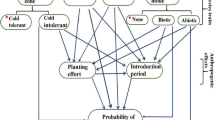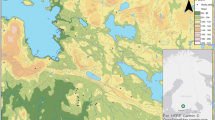Abstract
Damage to conifer seedlings caused by the pine weevil, Hylobius abietis, was estimated within eighty-two forest sites in Northern Ireland. A wide range of environmental variables were compared with the variation in damage between study sites using multiple logistic regression. Although 45 explanatory variables were considered only four were identified as significant within the final model. The four variables were the size of the planted area, the age of the planting, whether the majority of seedlings were self-seeded or planted, and if the site had been previously planted or was a newly planted area. The identification of these four variables indicates that it is possible to build a model identifying areas at risk to weevil damage. Further, although three of the factors have been recognised as significant influences on weevil damage for some time, they still remain important variables within British Isles forestry, suggesting that there is further scope for more precise targeting of weevil control measures.
Similar content being viewed by others
References
Aitken, M., Anderson, D., Francis, B. and Hinde, J. 1989. Statistical Modelling in GLIM. Clarendon Press, Oxford.
Berryman, A. A. and Stark, R. W. 1989. Assessing the risk of forest insect outbreaks. J. Appl. Ent. 99: 199–208.
Butterworth, E. W. and McIntosh, R. L. 1990. Development of Hazard Rating for the Seedling Debarking Weevil Using the Pitfall Trap. Research Production Council, New Brunswick Federation, New Brunswick.
Christiansen, E. and Sandvick, M. 1974. Damage by Hylobius abietis to Scots pine on scarified patches. Norsk Skogbr. 20: 8–9.
Crawley, M.J. 1993. GLIM for Ecologists. Blackwell Scientific Publications, Oxford.
Eidmann, H. H. 1968. Invasion of conifer plantations by radio-actively labelled Hylobius abietis, pp. 75–84. In. Isotopes and Radiation in Entomology: Proceedings of a Symposium, Vienna International Atomic Energy Agency, Vienna.
Eidmann, H. H. 1979. Integrated management of pine weevil (Hylobius abietis L.) populations in Sweden, pp. 103–109. In: Waters, W. E. (Ed) Current Topics of Forest Entomology U.S.D.A. Forestry Service General Technical Report WO8, E.D.
Elton, E. T. G., Blankwaardt, H. F. H., Burger, H. C., Steemers, W. F. and Tichelman, L. C. 1964. Insect communities in barked and unbarked pine stumps, with special reference to the large pine weevil (Hylobius abietis L.) Coleoptera, Curculionidae. J. App. Ent. 55: 1–54.
Glowacka, B., Lech, A. and Wilczynski, W. 1991. Application of deltamethrin for spraying or dipping to protect Scots pine seedlings against Hylobius abietis L. and logs against Tomicus piniperda L. Ann. Sci. For. (Paris) 48: 113–117.
Heritage, S., Collins, S. and Evans, H. F. 1989. A survey of damage by Hylobius abietis and Hylastes species in Britain, pp. 36–42. In: Alfaro, R. I. and Glover, S. G. (Eds) Insects Affecting Reafforestation: Biology and Damage. Forestry, Canada, Victoria, Canada.
Hill, M. O. 1979. TWINSPAN. A FORTRAN Programme for Arranging Multivariate Data in Ordered Two-way Table by Classification of Individuals and Attributes. Ecology and Systematics Ithaca. Cornell University, New York.
Hunt, D. W. A., Lintereur, G., Salom, S. M. and Raffa, K. F. 1993. Performance and preference of Hylobius radicis (Buchanan), and H. pales (Herbst) (Coleoptera: Curculionidae) on various Pinus species. Can. Ent. 125: 1003–1010.
Huser, R. 1979. Height growth of a Scots pine plantation in the Upper Palatinate, with and without deep ploughing. Forstwiss. Cbl. 98: 258–263.
Korczynski, I. 1988. Seasonal changes in the spatial distribution of feeding by the pine weevil Hylobius abietis in Scots pine plantations. Sylwan 132: 49–53.
Långström, B. 1982. Abundance and seasonal activity of adult Hylobius weevils in reforestation areas during first years following final felling. Commun. Inst. For. Fenn. 106: 1–23.
Löyttyniemi, K. and Hiltunen, R. 1976. The effect of nitrogen fertilization and terpene content on the attractiveness of pine trapping bolts to Hylobius abietis L. and Pissodes pini F. (Coleoptera: Curculionidae). Ann. Ent. Fenn. 42: 185–187.
Luik, A. and Voolma, K. 1989. Some aspects of the occurrence, biology and cold-hardiness of Hylobius weevils, pp. 36–42. In: Alfaro, R. I. and Glover, S. G. (Eds) Insects Affecting Reforestation: Biology and Damage. Forestry Canada, Victoria, Canada.
Malphettes, C. B., Fougères, D. and Saintonge, F. X. 1995. Untersuchung über der Sexualentwicklung der mit Kairomomenfallen gefangenen Weibchen des grossen braunen Rüsselkäfers (Hylobius abietis L.) (Coleoptera: Curculionidae). Anzeiger für Schädlingskunde und Umweltschutz (in press).
Munro, J. W. 1928. The biology and control of Hylobius abietis L. Forestry 2: 31–39.
Nef, L. and Minet, G. 1992. Evaluation des risques de dégats de Hylobius abietis L. dans les jeunes plantations de conifères. Silva Bel. 99: 15–20.
Nordlander, G. 1987. A method for trapping Hylobius abietis (L.) with a standardized bait and its potential for forecasting seedling damage. Scand. J. For. Res. 2: 199–213.
Österström, L. O. and Andersson, B. 1975. Site preparation checks Hylobius abietis. Skogsagaren 51: 30–31.
Pendrel, B. A. 1990. Hazard from the seedling debarking weevil: a revised key to predicting damage on sites to be planted. Forestry Canada-Maritimes Region Technical Note 236, pp
Quinn, J. P., Pendrel, B. A., Stewart, J. V and Murray, T. 1989. Controlling the seedling debarking weevil: an economic analysis. Forestry Canada-Maritimes Region Technical Note 202: pp 7.
Scott, T. M. and King, C. J. 1974. The large pine weevil and black pine beetles. Forestry Commission Leaflet 58 pp 58 HMSO.
Selander, J. and Immonen, A. 1991. Effect of fertilization on the susceptibility of Scots pine seedlings to the large pine weevil Hylobius abietis. Fol. For. 761: 21 pp.
Selander, J. and Immonen, A. 1992. Effect of fertilization and watering of Scots pine seedlings on the feeding preference of the pine weevil (Hylobius abietis L.) Sylva Fenn. 26: 75–84.
Selander, J., Immonen, A. and Raukko, P. 1992. Resistance of naturally regenerated and nursery-raised Scots pine seedlings to the large pine weevil. Fol. For. 766: 199 pp.
Söderström, V. 1976. The effects of scarification before planting conifers on newly clearfelled areas. Svergies Skogsvårb. Tidskr. 74: 59–333.
Söderström, V. 1977. Problems and methods in forest regeneration IV. Trials with methods of soil preparation. K. Skogs o. Lantbr. Tidskr. 116: 43–52.
Söderström, V., Backe, J., Byfalk, R. and Jonsson, C. 1978. A comparison of mineral soil mounds with other soil treatments for planting. Rapporter och Uppsatser Insitutionen for Skogsskötsel 11: 177 pp.
Solbreck, C. 1980. Dispersal and migrating pine weevils, Hylobius abietis, Coleoptera: Curculionidae. Ent. exp. Appl. 28: 123–131.
Solbreck, C. and Gyldberg, B. 1979. Temporal flight pattern of the large pine weevil, Hylobius abietis L. (Coleoptera, Curculionidae) with special reference to the influence of weather. J. Appl. Ent. 88: 532–536.
Stadnitskii, G. V. 1978. Effect of the living ground vegetation on damage to Scots pine plantations by Hylobius abietis. Les. Zh.l 6: 26–29.
Swaine, G. 1951. Population studies on Hylobius abietis L. (Coleoptera: Curculionidae). Ann. Appl. Biol. 38: 606–614.
Turchinskaya, I. A. 1983. The silvicultural and biological basis of prophylactic measures against the pine weevil. Les. Khoz. 7: 50–51.
Welty, C. and Houseweart, M. W. 1985. Site influences on Hylobius congener (Coleoptera: Curculionidae), a seedling debarking weevil of conifer populations in Maine. Env. Ent. 14: 826–833.
Wilson, W. L. and Day, K. R. 1994. Spatial variation in damage dispersion, and the relationship between damage intensity and the abundance of the pine weevil (Hylobius abietis L.). Int. J. Pest Manage. 40: 46–49.
Wilson, W. L. and Day, K. R. 1996. Variation in the relative abundance of the large pine weevil among Sitka spruce plantation sites. Forestry 69: 169–171.
Zumr, V. and Starý, P. 1992. The occurrence of the large pine weevil Hylobius abietis (L.) in individual forest zones. For. Ecol. Manage. 51: 251–258.
Author information
Authors and Affiliations
Rights and permissions
About this article
Cite this article
Wilson, W.L., Day, K.R. & Hart, E.A. Predicting the extent of damage to conifer seedlings by the pine weevil (Hylobius abietis L.): a preliminary risk model by multiple logistic regression. New Forest 12, 203–222 (1996). https://doi.org/10.1007/BF00027932
Received:
Accepted:
Issue Date:
DOI: https://doi.org/10.1007/BF00027932




